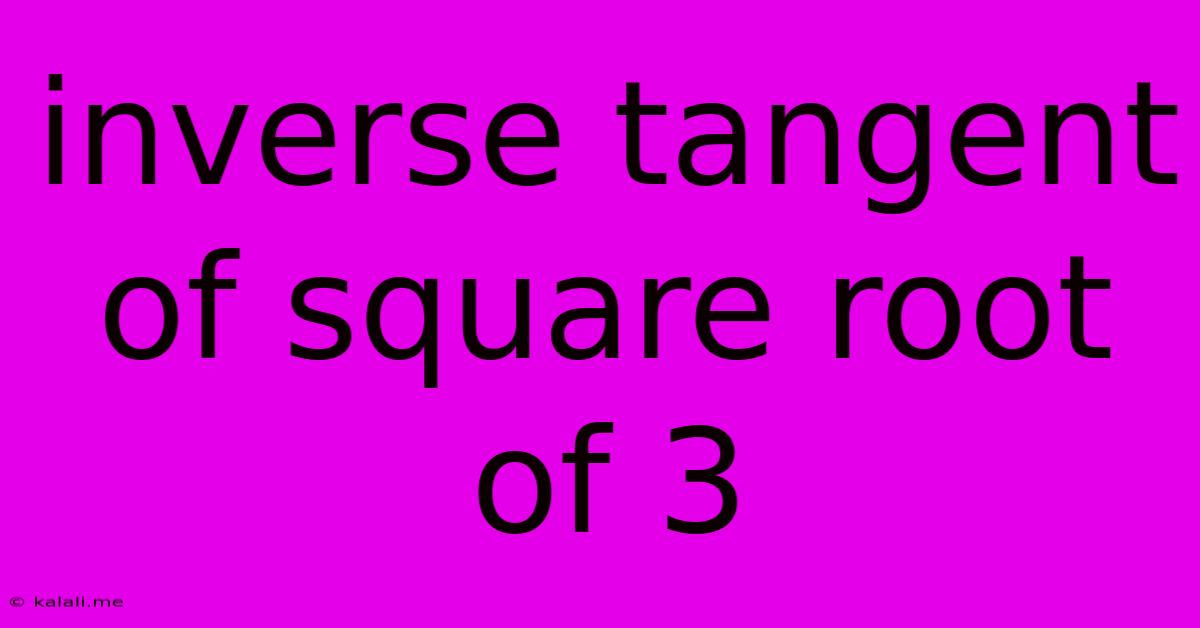Inverse Tangent Of Square Root Of 3
Kalali
Jun 07, 2025 · 3 min read

Table of Contents
Unveiling the Mystery: Understanding the Inverse Tangent of √3
This article delves into the intriguing mathematical concept of the inverse tangent of the square root of 3 (arctan(√3) or tan⁻¹(√3)). We'll explore its value, its application in various fields, and how to understand its meaning both conceptually and computationally. Understanding this concept is crucial for anyone working with trigonometry, calculus, or related fields.
The inverse tangent function, also known as arctangent, finds the angle whose tangent is a given value. In simpler terms, it answers the question: "What angle has a tangent equal to this number?" In our case, we want to find the angle whose tangent is √3.
What is the Value of arctan(√3)?
The principal value of arctan(√3) is 60° or π/3 radians. This means that the tangent of 60° (or π/3 radians) is equal to √3. This result stems from the fundamental trigonometric ratios defined within a 30-60-90 triangle. Remember, the tangent of an angle in a right-angled triangle is the ratio of the length of the side opposite the angle to the length of the side adjacent to the angle.
However, it's crucial to remember that the tangent function is periodic, meaning it repeats its values every 180° (or π radians). Therefore, there are infinitely many angles whose tangent is √3. These angles can be expressed as:
- 60° + 180°n (in degrees)
- π/3 + πn (in radians)
where 'n' is any integer (positive, negative, or zero).
Understanding the Unit Circle
Visualizing the unit circle is extremely helpful for understanding this concept. The unit circle is a circle with a radius of 1, centered at the origin of a coordinate plane. Angles are measured counterclockwise from the positive x-axis. The tangent of an angle is the y-coordinate divided by the x-coordinate of the point where the terminal side of the angle intersects the unit circle. Finding an angle with a tangent of √3 involves identifying the point on the unit circle where this ratio holds true.
Applications of arctan(√3)
The arctangent of √3 has applications in various fields, including:
- Physics: Calculating angles in projectile motion, analyzing forces and vectors.
- Engineering: Designing structures, analyzing circuits, and solving problems involving oscillations.
- Computer Graphics: Used in transformations and rotations.
- Navigation: Determining bearings and directions.
Solving Problems Involving arctan(√3)
Let's consider a practical example: Imagine a right-angled triangle where the side opposite an angle is √3 times the length of the side adjacent to the angle. To find the value of this angle, you would use the arctangent function: arctan(√3) = 60°. This simple application highlights the practical utility of understanding this trigonometric concept.
Conclusion: Mastering the Inverse Tangent
Understanding the inverse tangent of √3 is a fundamental step in mastering trigonometry. By grasping its value, its multiple solutions, and its visual representation on the unit circle, you'll build a solid foundation for tackling more complex mathematical and real-world problems. Remember the core concept: arctan(√3) provides the angle whose tangent equals √3, and understanding its periodic nature is essential for a comprehensive understanding.
Latest Posts
Latest Posts
-
Can I Take Glass On A Plane
Jun 08, 2025
-
Cups In Box Of Powdered Sugar
Jun 08, 2025
-
Can I Use Potato Starch Instead Of Cornstarch
Jun 08, 2025
-
What Tribe Of Israel Am I Descended From
Jun 08, 2025
-
How Do You Take Off Restricted Mode On Youtube
Jun 08, 2025
Related Post
Thank you for visiting our website which covers about Inverse Tangent Of Square Root Of 3 . We hope the information provided has been useful to you. Feel free to contact us if you have any questions or need further assistance. See you next time and don't miss to bookmark.